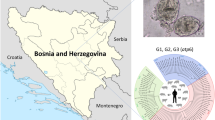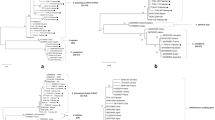Abstract
In Algeria, previous studies investigated genotypes of Echinococcus granulosus sensu lato in animals and identified E. granulosus sensu stricto (s.s.) genotypes G1 and G3 whereas Echinococcus canadensis genotype G6 was only reported from dromedary cysts. Molecular data on human cystic echinococcosis (CE) were limited. We implemented a large genotyping study of hydatid cysts from humans and livestock animals to specify CE’s molecular epidemiology and the genetic diversity in Algeria. Fifty-four human CE cysts from patients predominantly admitted in surgical units from Mustapha Hospital, Algiers, and 16 cysts from livestock animals gathered in two geographically distinct slaughterhouses, Tiaret and Tamanrasset, were collected. Molecular characterization was performed using sequencing of two mitochondrial genes, cytochrome c oxidase subunit I (COI) and NADH dehydrogenase subunit I (NDI). In humans, G1 of E. granulosus s.s. was the main genotype (90.7 %); four samples (7.4 %) were characterized as E. granulosus s.s. G3 and one cyst as E. canadensis G6 (1.8 %). This molecular confirmation of E. canadensis G6 human infection in Algeria was observed in a Tuareg female living in a desertic area in Tamanrasset. All cysts from sheep, cattle, and goat were identified as E. granulosus s.s. G1 and the two cysts originating from dromedary as E. canadensis G6. Twenty concatenated haplotypes (COI + NDI) were characterized. Among E. granulosus s.s., one haplotype (HL1) was highly predominant in both humans and animals cysts (71.6 %). This study revealed main occurrence of E. granulosus s.s. in humans and livestock animals, with description of a predominant shared haplotype corresponding to the main worldwide observed haplotype E.granulosus s.s. G1. E. canadensis G6 was limited to South Algeria, in dromedary as well as in human.


Similar content being viewed by others
References
Aaty HE, Abdel-Hameed DM, Alam-Eldin YH, El-Shennawy SF, Aminou HA, Makled SS, Darweesh SK (2012) Molecular genotyping of Echinococcus granulosus in animal and human isolates from Egypt. Acta Trop 121(2):125–128
Abushhewa MH, Abushhiwa MH, Nolan MJ, Campbell BE, Jabbar A, Gasser RB (2010) Genetic classification of Echinococcus granulosus cysts from humans, cattle and camels in Libya using mutation scanning-based analysis of mitochondrial loci. Mol Cell Probes 24(6):346–351
Alvarez Rojas CA, Romig T, Lightowlers MW (2014) Echinococcus granulosus sensu lato genotypes infecting humans – review of current knowledge. Int J Parasitol 44:9–18
Bardonnet K, Benchikh-Elfegoun MC, Bart JM, Harraga S, Hannache N, Haddad S, Dumon H, Vuitton DA, Piarroux R (2003) Cystic echinococcosis in Algeria: cattle act a reservoirs of a sheep strain and may contribute to human contamination. Vet Parasitol 116:35–44
Bardonnet K, Piarroux R, Dia L, Scheegans F, Beurdeley A, Godot V, Vuitton DA (2002) Combined ecoepidemiological and molecular biology approches to assess Echinococcus granulosus transmission to human in Mauritania:occurance of the camel strain and human cystic echinococcosis. Trans R Soc Trop Med Hyg 96:383–386
Bart JM, Bardonnet K, Elfegoun MCB, Dumon H, Dia L, Vuitton DA, Piarroux R (2004) Echinococcus granulosus strain typing in North Africa: comparison of eight nuclear and mitochondrial DNA fragments. Parasitology 128:229–234
Bart JM, Morariu S, Knapp J, Ilie MS, Pitulescu M, Anghel A, Cosoroaba I, Piarroux R (2006) Genetic typing of Echinococcus granulosus in Romania. Parasitol Res 98(2):130–137
Bentounsi B, Meradi S, Ayachi A, Cabaret J (2009) Cestodes of untreated large stray dog populations in Algeria : a reservoir for herbivore and human parasitic diseases. Open Vet Sci J 3:64–67
Bowles J, Blair D, McManus DP (1992) Genetic variants within the genus Echinococcus identified by mitochondrial DNA sequencing. Mol Biochem Parasitol 54(2):165–173
Bowles J, McManus DP (1993) NADH dehydrogenase 1 gene sequences compared for species and strains of the genus Echinococcus. Int J Parasitol 23(7):969–972
Boufana B, Lahmar S, Rebai W, Ben Safta Z, Jebabli L, Ammar A et al (2014) Genetic variability and haplotypes of Echinococcus isolates from Tunisia. Trans R Soc Trop Med Hyg 108(11):706–714
Carmena D, Gardona GA (2013) Canine echinococcosis. Global epidemiology and genotypic diversity. Acta Trop 128(3):441–460
Cardona GA, Carmena D (2013) A rewiew of global prevalence, molecular epidemiology and economics of cystic echinococcosis in production animals. Vet Parasitol 192(1-3):10–32
Casulli A, Interisano M, Sreter T, Chitimia L, Kirkova Z, La Rosa G, Pozio E (2012) Genetic variability of Echinococcus granulosus sensu stricto in Europe inferred by mitochondrial DNA sequences. Infect Genet Evol 12(2):377–383
Clement M, Posada D, Crandall (2000) KATCS:a Computer program to estimate gene genealogies. Mol Ecol 9(10):1657–1660
Dakkak A (2010) Echinococcosis/hydatidosis: a severe threat in Mediterranean countries. Vet Parasitol 174(1-2):2–11
El Berbri I, Petavy AF, Umhang G, Bouslikhane M, Fassi Fihri O, Boué F et al (2015) Epidemiological Investigations on Cystic Echinococcosis in North-West (Sidi Kacem Province) Morocco: Infection in Ruminants. AdvEpidemiol 2015:1-9. doi:10.1155/2015/104025
Ghalmi F, Zebiri E, Sekat NI (2014) Evaluation of the infection by Echinococcus granulosus in stray dogs in the region of Algiers: ante- and post-mortem exams In Vuitton D.A. et al. Proceedings of the International Symposium Innovation for the Management of Echinococcosis Besancon, March 27–29. Parasite 21:28. doi:10.1051/parasite/2014024
Hall TA (1999) BioEdit Sequence alignement Editor. Nucleic Acids Symp Ser 41:95–98
Hamrat K, Achour Y, Benhousse A, Cozma V (2011) Study of the prevalence of Echinococcus granulosus in the south of Algeria (as in the ADRAR region). Sci Parasitol 12(4):219–221
Hüttner M, Nakao M, Wassermann T, Siefert L, Boomker JD, Dinkel A, Sako Y, Mackenstedt U, Romig T, Ito A (2008) Genetic characterization and phylogenetic position of Echinococcus felidis (Cestoda: Taeniidae) from the African lion. Int J Parasitol 38:861–868
Khalifa ON, Khater HF, Fahmy HA, Radwan ME, Afify JS (2014) Genotyping and Phylogenetic Analysis of Cystic Echinococcosis Isolated from Camels and Humans in Egypt. Am J Epidemiol Infect Dis 2(3):74–82
Kouidri M, Benchaib-Khoudja F, Boulkaboul A, Selles SMA (2013) Cystic Echinococcosis in Small Ruminants in Tiaret (Algeria). Glob Vet 11(6):753–758
Kouidri M, Benchaib-Khoudja F, Boulkaboul A et al (2012) Prevalence, fertility and viability of cystic echinococcosis in sheep and cattle of Algeria. Bulg J Vet Med 15(3):191–197
Lahmar S, Debbek H, Zhang LH, McManus DP, Souissi A, Chelly S, Torgerson PR (2004) Transmission dynamics of the Echinococcus granulosus sheep-dog strain (G1 genotype) in camels in Tunisia. Vet Parasitol 121(1-2):151–156
Lavikainen A, Lehtinen MJ, Meri T, Hirvela-Koski V, Meri S (2003) Molecular genetic characterisation of the Fennoscandien cervid strain, a new genotypic group (G10) of Echinococcus granulosus. Parasitology 127:207–215
Maillard S, Gottstein B, Haag KL, Ma S, Colovic I, Benchikh-Elfegoun MC et al (2009) The EmsB tandemly repeated multilocus microsatellite: a new tool to investigate genetic diversity of Echinococcus granulosus sensu lato. J Clin Microbiol 47(11):3608–3616
Maillard S, Benchikh-Elfegoun MC, Knapp J, Bart JM, Koskei P, Gottstein B, Piarroux R (2007) Taxonomic position and geographical distribution of the common sheep G1 and camel G6 strains of Echinococcus granulosus in three African countries. Parasitol Res 100(3):495–503
Mauti S, Traoré A, Crump L, Zinsstag J, Grimm F (2016) First report of Echinococcus granulosus (genotype G6) in a dog in Bamako. Mali Vet Parasitol 217:61–63
McManus D. P. (2013) Current status of the genetics and molecular taxonomy of Echinococcus species. Parasitology 1–7. doi:10.1017/S0031182013000802
M’rad S, Oudni-M’rad M, Filisetti D, Mekki M, Nouri A, Sayadi T, Candolfi E, Azaiez R, Mezhoud H, Babba H (2010) Molecular identification of Echincoccus granulosus in Tunisia: first record of the buffalo strain (G3) in human and bovine in the country. OpenVet Sci J 4:20–23
M’rad S, Filisetti D, Oudni M, Mekki M, Belguith M, Nouri et al (2005) Molecular evidence of ovine (G1) and camel (G6) strains of Echinococcus granulosus in Tunisia and putative role of cattle in human contamination. Vet Parasitol 129(3-4):267–72
Nakao M, Lavikainen A, Yanagida T, Ito A (2013a) Phylogenetic systematics of the genus Echinococcus (Cestoda: Taeniidae). Int J Parasitol 44:9–18
Nakao M, Yanagida T, Konyaev S, Lavikainen A, Odnokurtsev VA, Zaikov VA, Ito A (2013b) Mitochondrial phylogeny of the genus Echinococcus (Cestoda: Taeniidae) with emphasis on relation-ships among Echinococcus canadensis genotypes. Parasitology 140:1625–1636
Romig T, Ebi D, Wassermann M (2015) Taxonomy and molecular epidemiology of Echinococcus granulosus sensu lato. Vet Parasitol 213:76–84
Ouchene N, Bitam I, Zeroual F, Ouchene-Khelifi NA (2014) Cystic echinococcosis in wild boars (Sus scrofa) and slaughtered domestic ruminants in Algéria. As J Anim Vet Adv 9(12):767–774
Oudni-M’rad M, M’rad S, Ksia A, Lamiri R, Mekki M, Nouri A, Mezhoud H, Babba H (2016) First molecular evidence of the simultaneous human infection with two species of Echinococcus granulosus sensu lato: Echinococcus granulosus sensu stricto and Echinococcus canadensis. Parasitol Res 115(3):1065–1069. doi:10.1007/s00436-015-4836-x
Sadjjadi SM, Mikaeili F, Karamian M, Maraghi S, Sadjjadi FS, Shariat-Torbaghan S et al (2013) Evidence that the Echinococcus granulosus G6 genotype has an affinity for the brain in humans. Int J Parasitol 43(11):875–877
Schneider R, Gollackner B, Schindl M, Tucek G, Auer H (2010) Echinococcus canadensis G7 (Pig Strain): an underestimated cause of cystic echinococcosis in Austria. Am J Trop Med Hyg 82(5):871–874
Snabel V, Altintas N, D’Amelio S, Nakao M, Romig T, Yolasigmaz A et al (2009) Cystic echinococcosis in Turkey: genetic variability and first record of the pig strain (G7) in the country. Parasitol Res 105(1):145–154
Tigre W, Deresa B, Haile A, Gabriël S, Victor B, Van Pelt J, Devleesschauwer B et al (2016) Molecular characterization of Echinococcus granulosus s.l. cysts from cattle, camels, goats and pigs in Ethiopia. Vet Parasitol 215:17–21
Umhang G, Chihai O, Boué F (2014) Molecular characterisation of Echinococcus granulosus in a hyperendemic European focus, The Republic of Moldova. Parasitol Res 113(12):4371–4376
Yanagida T, Mohammadzadeh T, Kamhawi S, Nakao M, Sadjjadi SM, Hijjawi N, Abdel-Hafez SK, Sako Y, Okamoto M, Ito A (2012) Genetic polymorphisms of Echinococcus granulosus sensu stricto in the Middle East. Parasitol Int 61:599–603
Zait H, Boulahbel M, Normand AC, Zait F, Achir I, Guerchani MK et al (2014) Parasitological study of 78 cases of human cystic echinococcosis collected between 2005 to 2012 in Mustapha hospital center of Algiers. Pathol Biol 62(6):369–376
Author information
Authors and Affiliations
Corresponding author
Ethics declarations
All adult subjects and parents/guardians of the children gave their written informed consent for surgery. Institutional Review Committees of our institution validated design of this study.
Conflict of interest
The authors declare that they have no conflict of interest.
Additional information
Highlights
– We have reported new data on the molecular epidemiology of cystic echinococcosis in Algeria.
– This study has explored the genetic diversity of E. granulosus s.l. especially in humans.
– The results revealed predominantly occurrence of E. granulosus s.s. G1 in humans and livestock animals with 90.7 %.
– E. canadensis G6 was found in two cysts originating from dromedary as well as one cyst originating from human.
Rights and permissions
About this article
Cite this article
Zait, H., Kouidri, M., Grenouillet, F.E. et al. Molecular characterization of Echinococcus granulosus sensu stricto and Echinococcus canadensis in humans and livestock from Algeria. Parasitol Res 115, 2423–2431 (2016). https://doi.org/10.1007/s00436-016-4994-5
Received:
Accepted:
Published:
Issue Date:
DOI: https://doi.org/10.1007/s00436-016-4994-5




